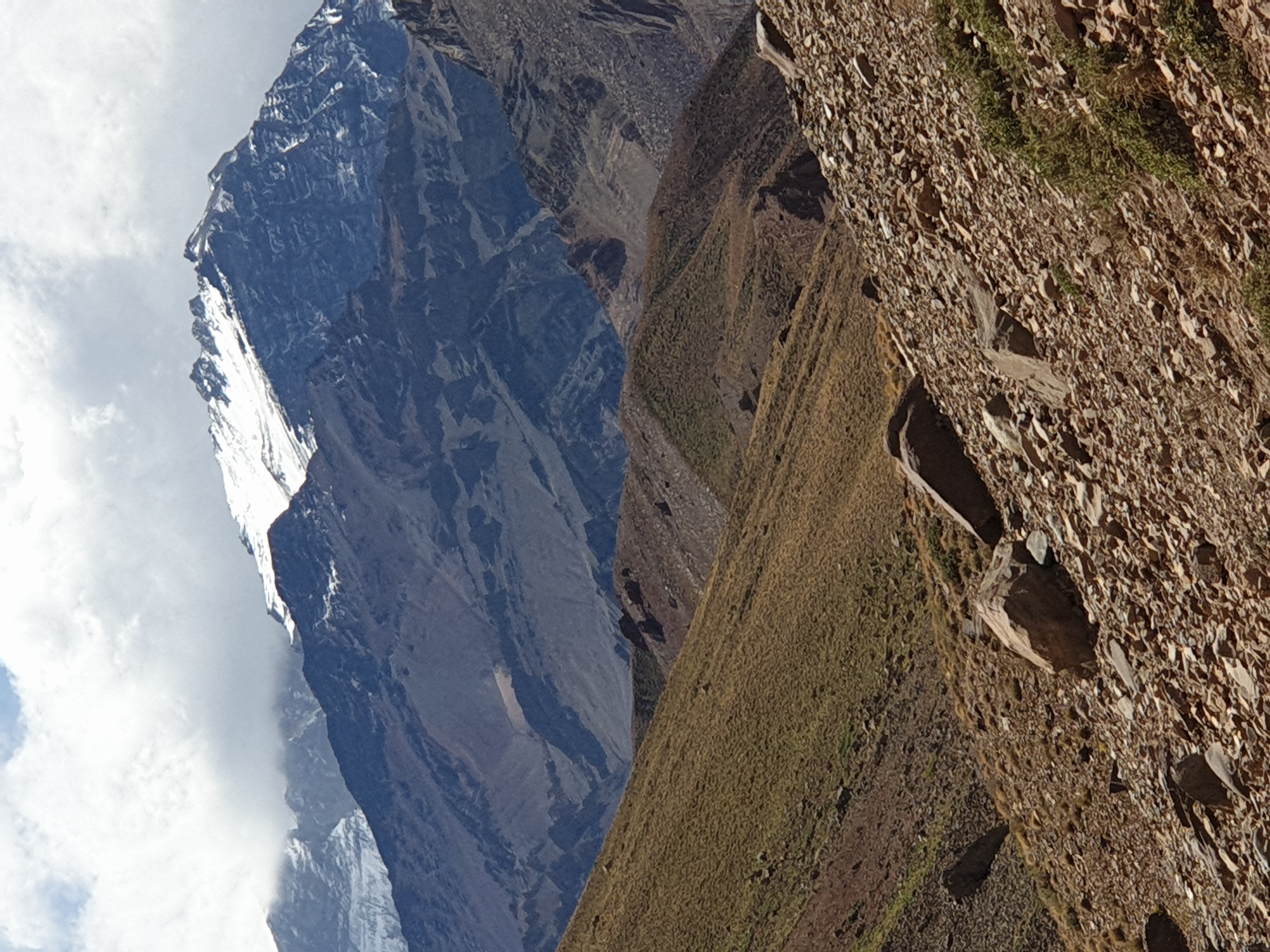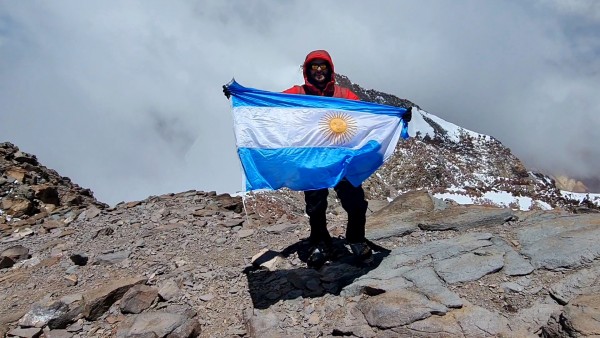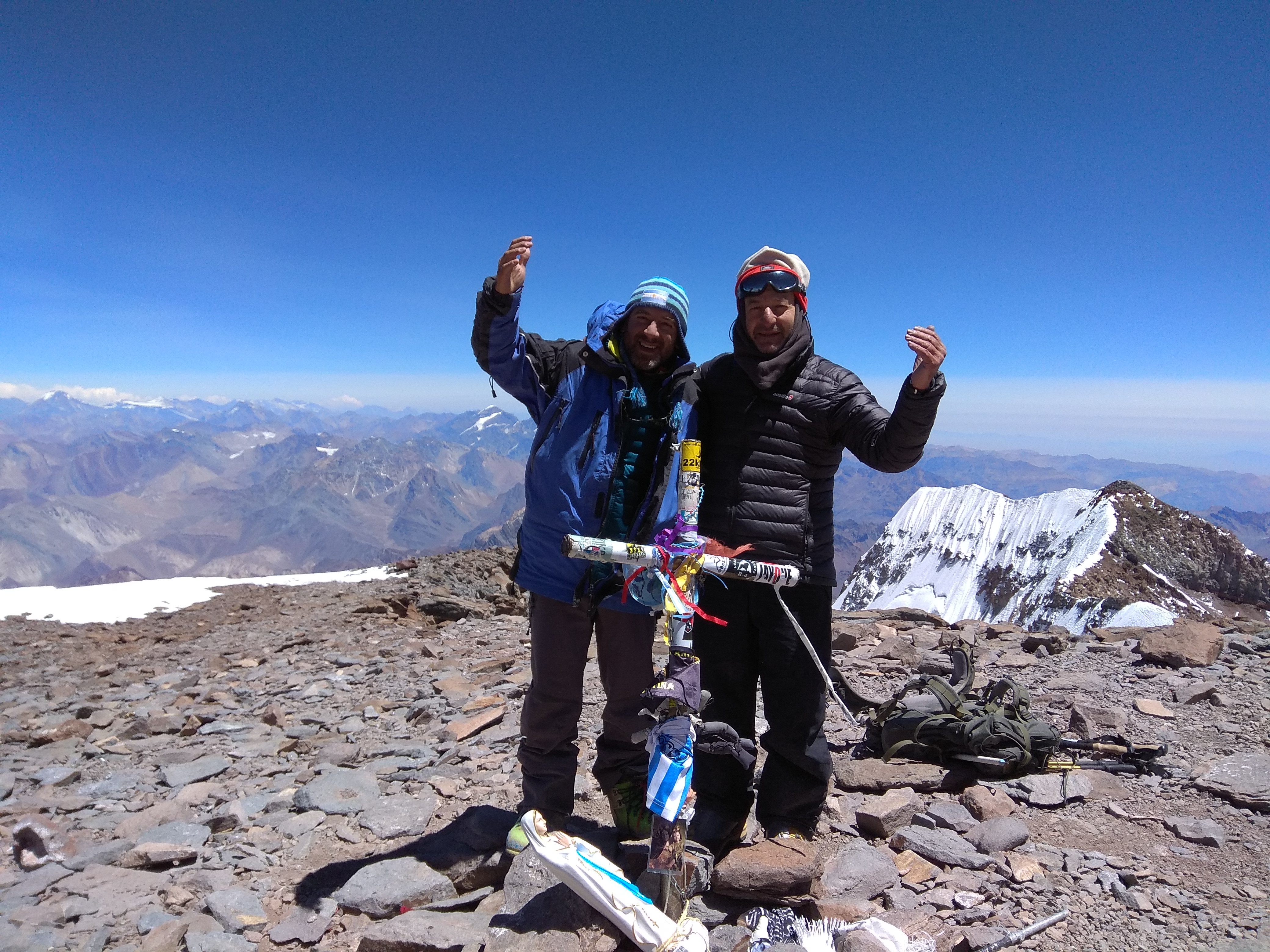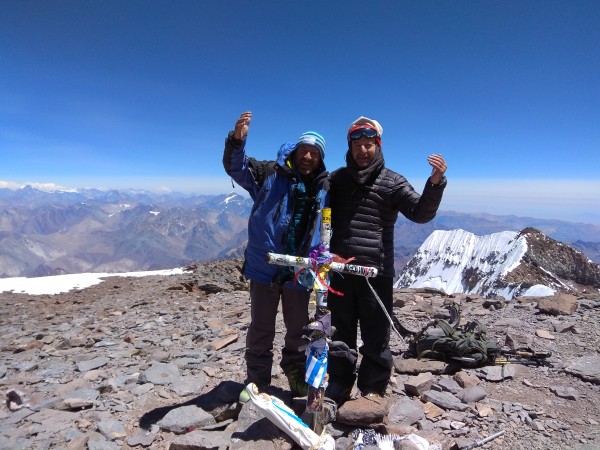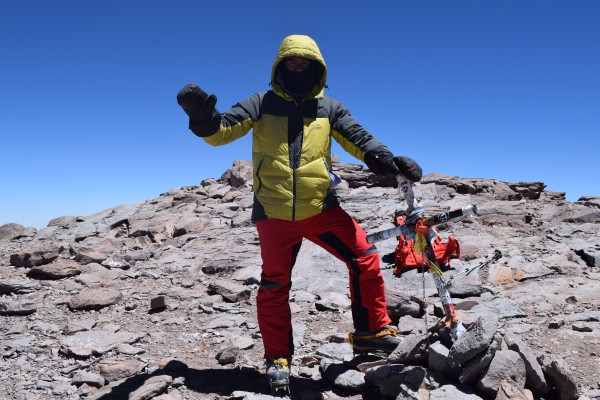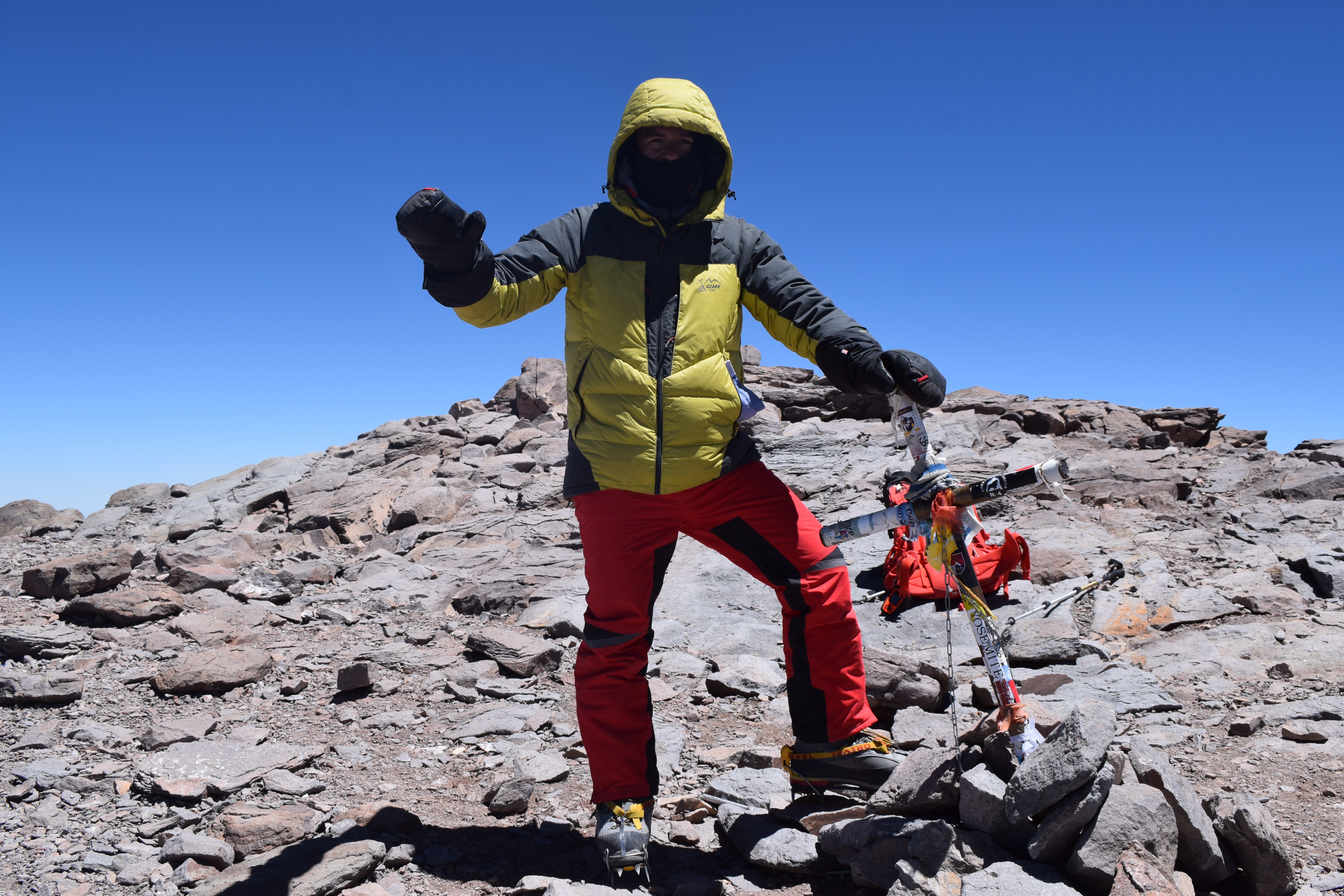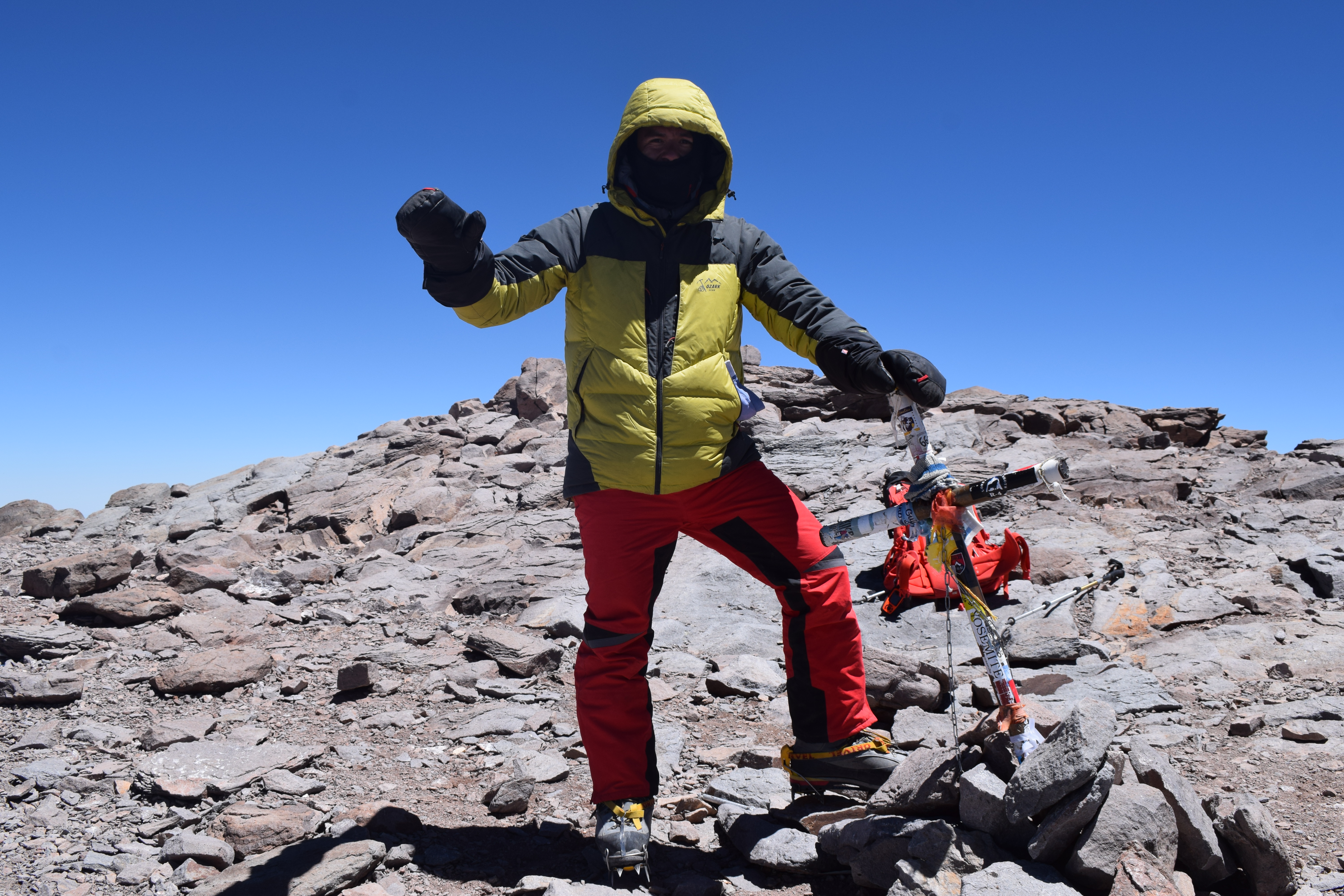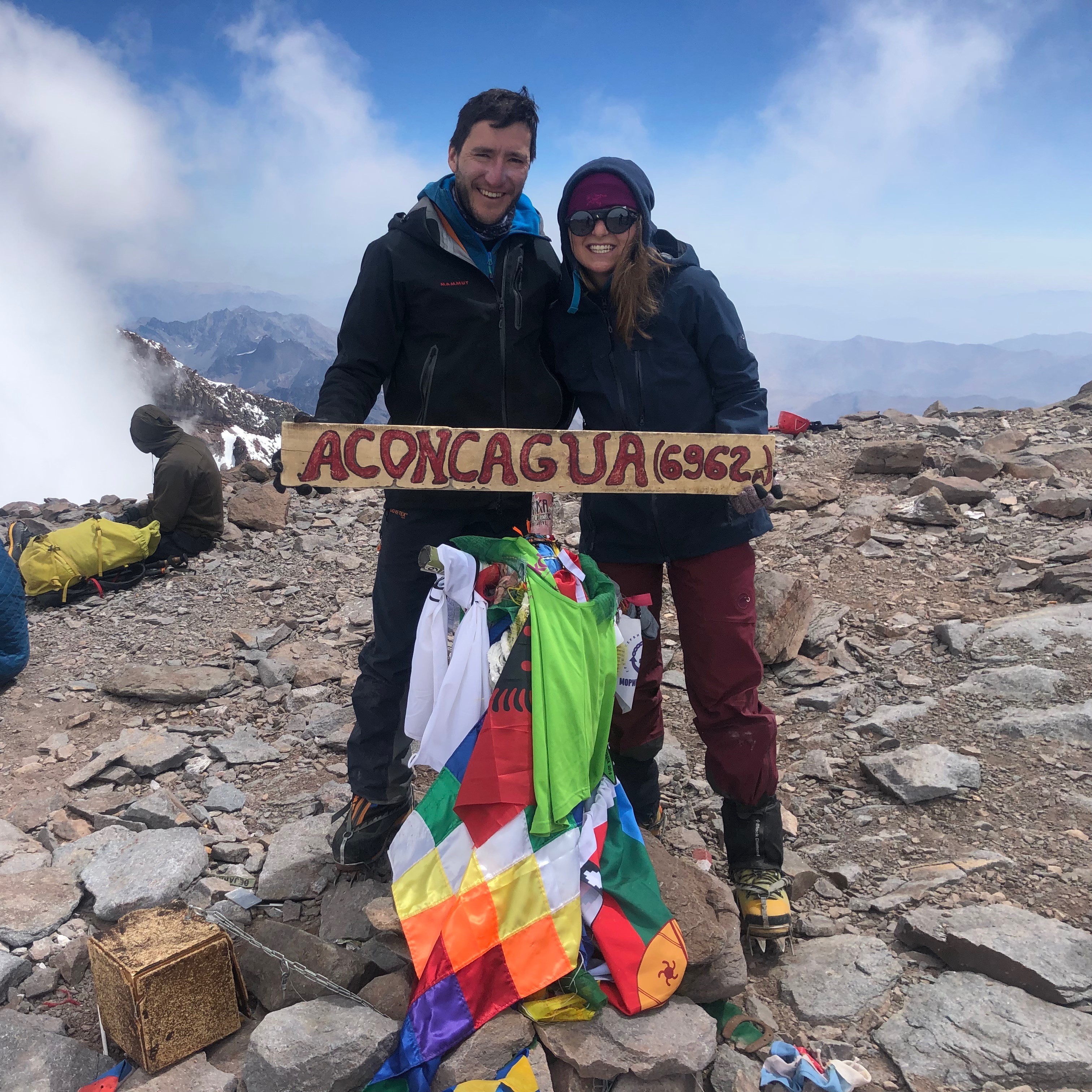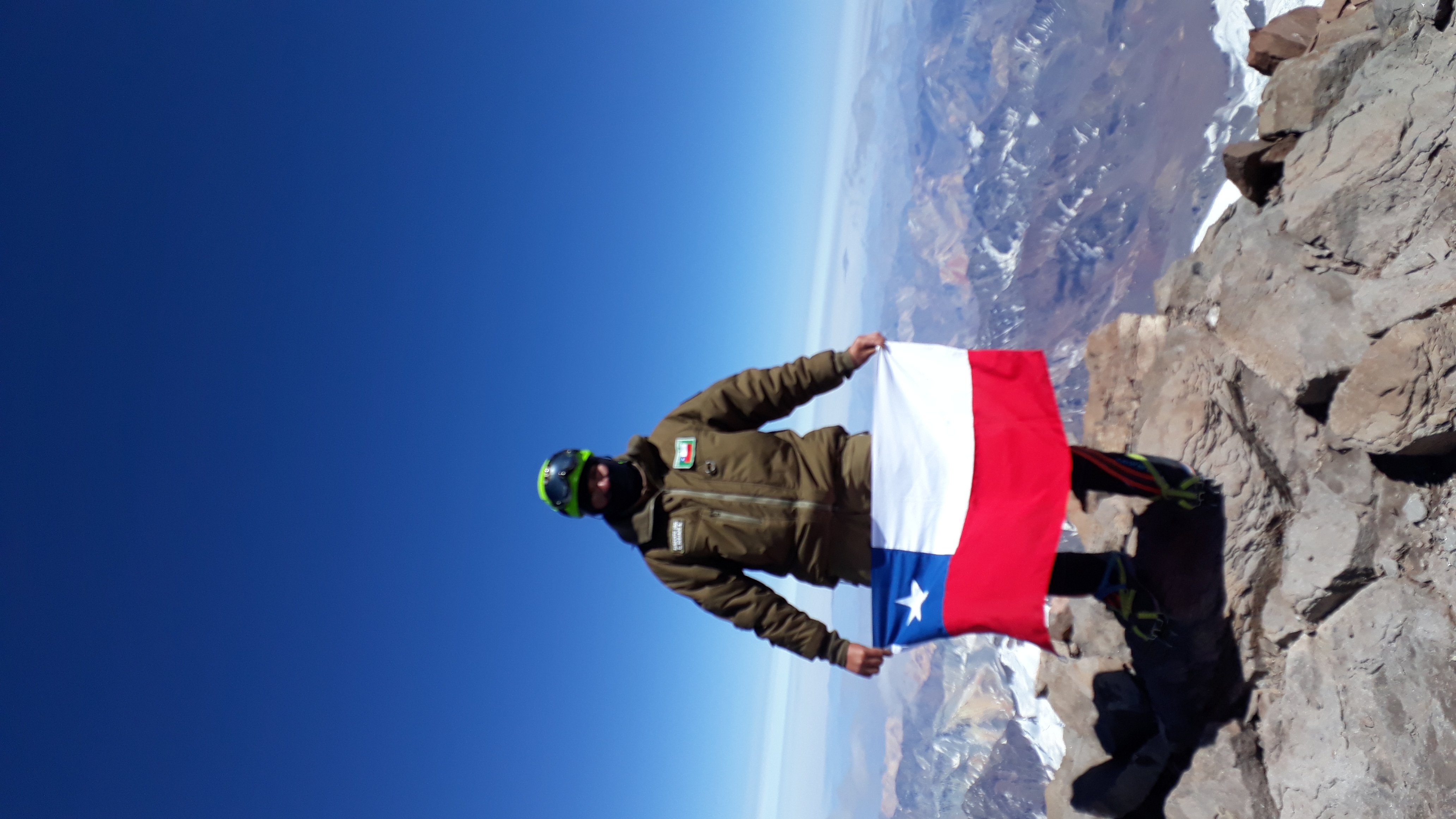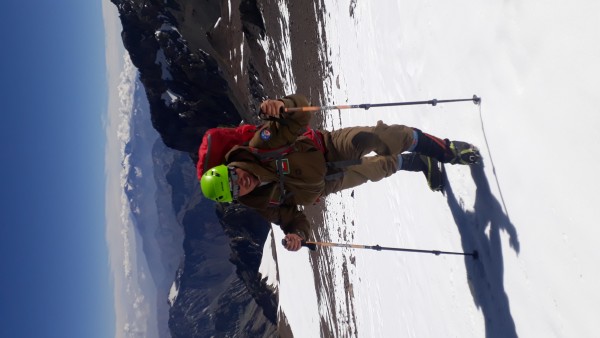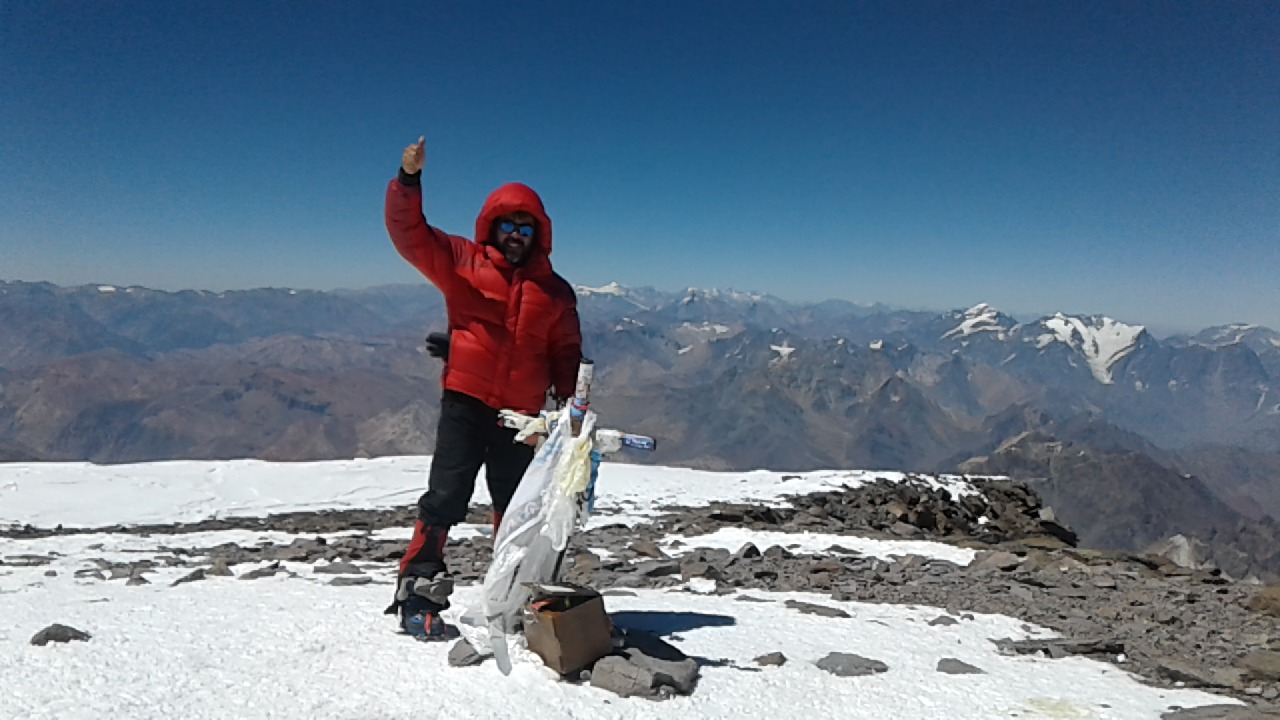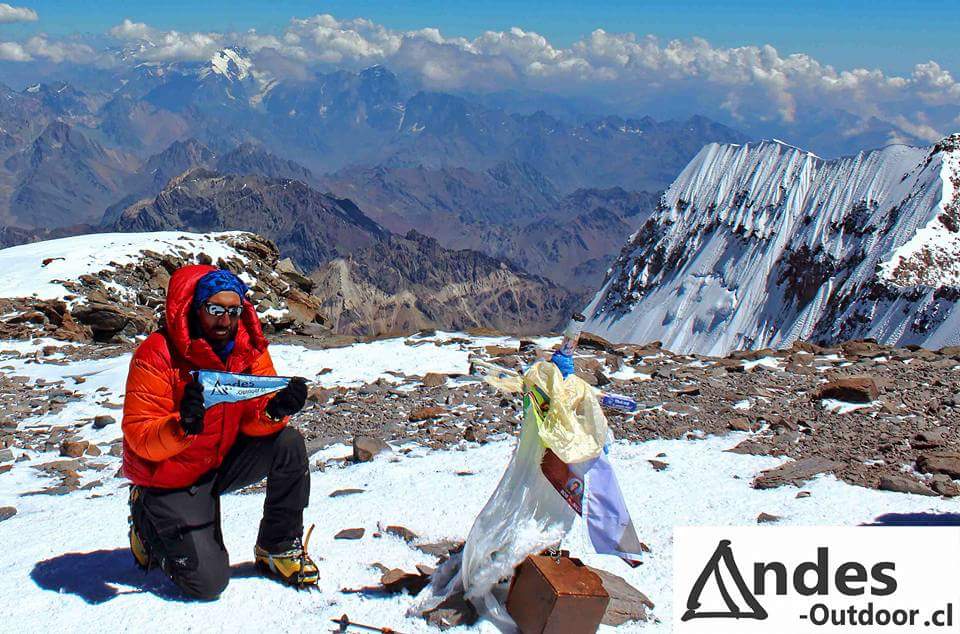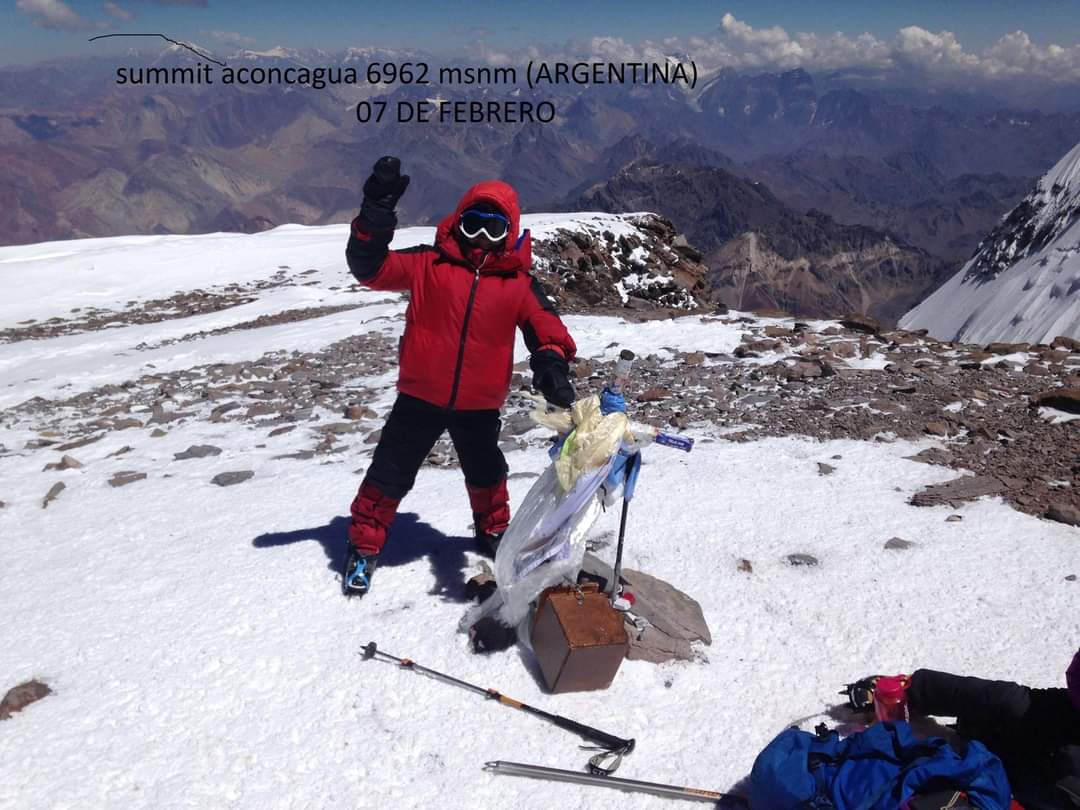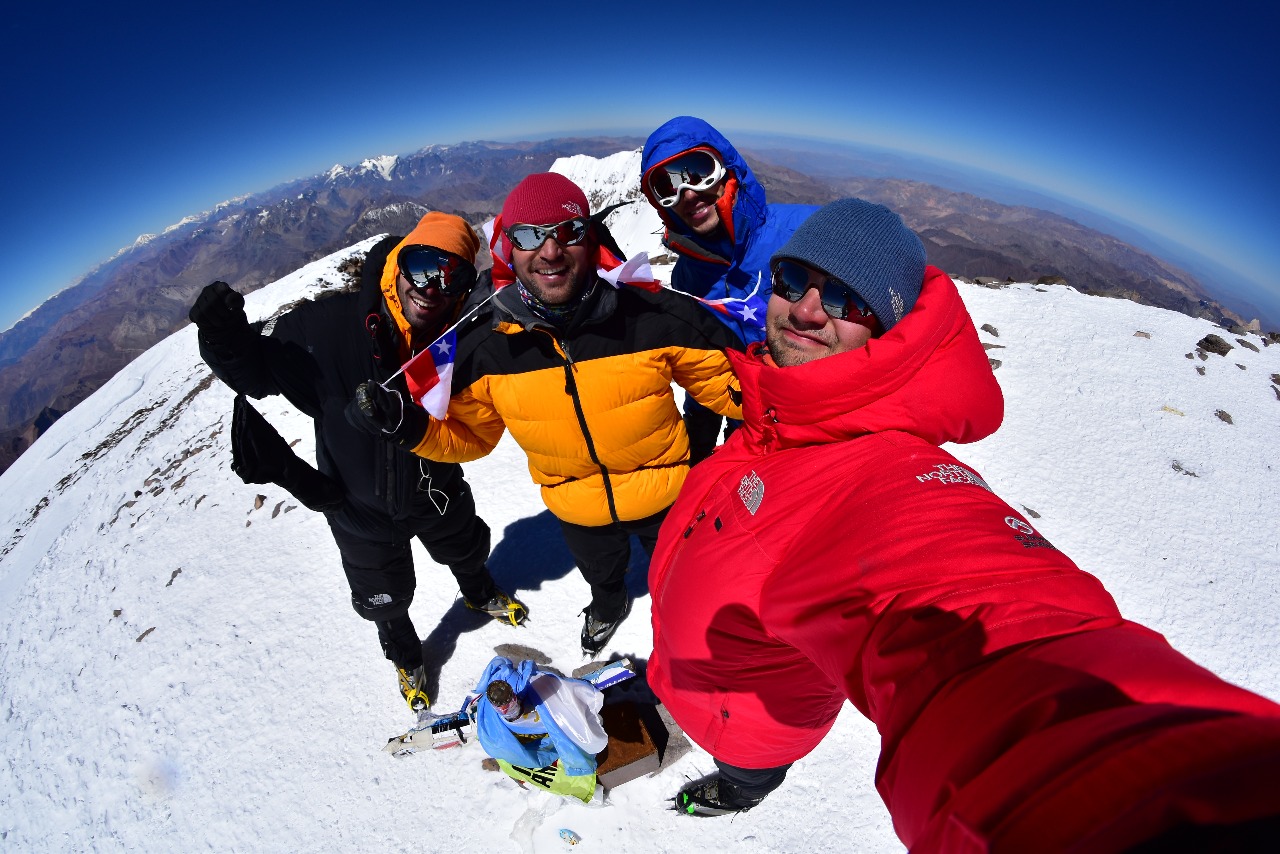Cerro Aconcagua (6.959m)
Provincia de Mendoza, Aconcagua / Ciudad cercana: Mendoza
Santiago
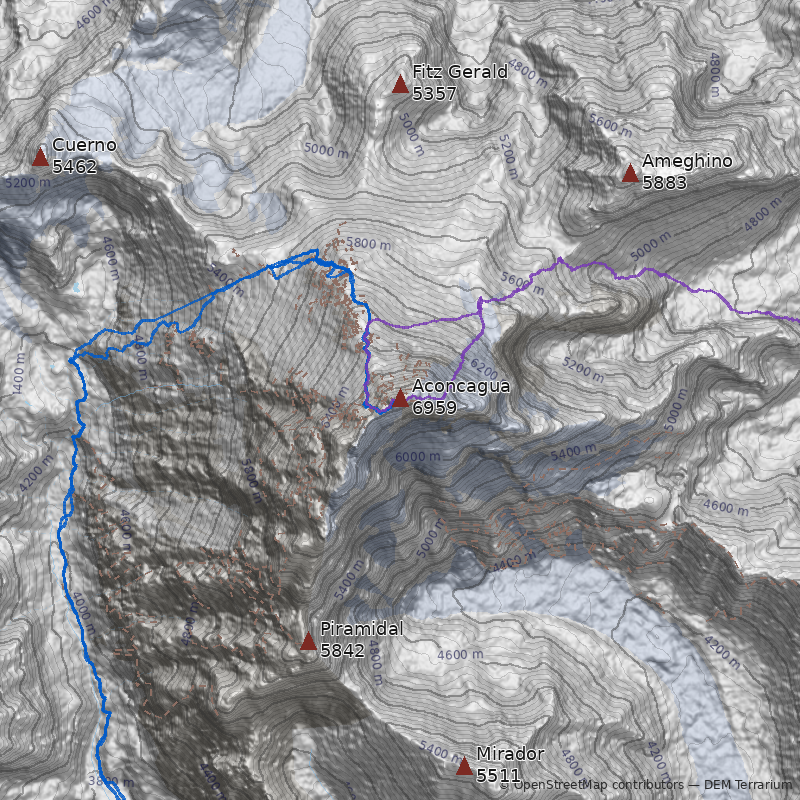 AHB Maps
AHB Maps
Fecha publicación: 15-12-2001
Última actualización: 22-11-2024
Presentación
El Aconcagua es la montaña más alta de Los Andes; su cumbre es el punto más alto del Hemisferio Sur; de los seismiles que lo rodean, ninguno se le compara en altura como para crear dudas; sus glaciares se ven desde la bahía de Valparaíso en Chile y desde Mendoza; su fisonomía desordenada y abultada es notoria. De ninguna forma puede este enorme cerro pasar desapercibido.
Por el norte es seco y abundante en acarreos y pedregales, y de figura muy amorfa. Por el Oeste tiene forma triangular, siendo muy rocoso y de pendiente abrupta. La roca no es buena por este lado y pocos intentan subir por esta vertiente. Por el Este también tiene la figura clásica de un cerro triangular, aunque adornado por el glaciar de Polacos. Por el sur es simplemente imponente: una pared con más de 3000m de desnivel desde su base, profusa en glaciares y seracs que la mantienen siempre blanca. La cara sur intimida y es, las más de las veces, espeluznante.
Origen del nombre
Sobre el nombre hay varias teorías:
La primera es la que apoya el origen quechua. Según ésta, Aconcagua viene de la palabra quechua "Ackon-Cahuak", que significa "El Centinela Blanco".
La misma palabra en la cultura aimara significa "El Centinela de Piedra".
Por último, algunos sostienen que la palabra "Aconcagua" viene del mapudungun "Aconcahue", que significa "que viene del otro lado", refiriéndose al río homónimo que llega al Pacífico. Sin embargo, ningún curso de agua proveniente del Aconcagua escurre hacia este océano.
¿Aconcagua chileno?
El cerro no tiene ninguna piedra en territorio chileno, como muchos creen. Se encuentra íntegramente en Argentina, como parte del Parque Provincial Aconcagua, una de las 11 Reservas Naturales que forman el Sistema de Areas Naturales Protegidas de la Provincia cuyana de Mendoza. Como se mencionó más arriba, ningún curso de agua del cerro llega al Pacífico. Con ello, no se aplica la condición necesaria de límite, sobre la división de las aguas, según los tratados. Como puede verse en la foto principal, un valle entero (quebrada de Matienzo) antecede la mole, si se le observa desde Chile en dirección oeste-este. El extenso parque del Aconcagua (cerca de 71.000 hectáreas) se encuentra perfectamente resguardado y administrado, cosa que se refleja en los precios que hay que pagar para visitarlo.
¿Aconcagua volcán?
Por mucho tiempo se creyó que el Aconcagua era un volcán. Un observador inglés erróneamente confundió una tormenta eléctrica con una erupción volcánica. El receptor del relato era ni más ni menos que Charles Darwin, que divulgó la idea de que era un volcán. Estudios recientes señalan que el Aconcagua corresponde a la ladera sur de un volcán activo, pero hace más de 10 millones de años.
Aconcagua y Darwin
Entre 1832 y 1835, el sabio autor de la "Evolución de las Especies", Charles Darwin, recorrió gran parte del territorio chileno, como parte del renombrado periplo del Beagle. Darwin cruzó dos veces la Cordillera de los Andes en su parte central (una de ida, desde Chile a Argentina, por el paso Piuquenes; otra de vuelta, desde Argentina hacia Chile, por Uspallata).
De la gran mole escribió: "Esa inmensa masa irregular alcanza una altitud más considerable que el Chimborazo, porque según las triangulaciones hechas por los oficiales del Beagle, alcanza una altitud de 23.000 pies (6900m)" (23 de julio de 1835, desde las colinas de Valparaíso).
En otra parte: "En la cordillera de Chile Central, creo que el límite de de las nieves varía mucho en altura según los veranos. Se me ha asegurado que durante un estío muy largo y seco, toda la nieve del Aconcagua desapareció, aunque esta montaña adquiere la altitud prodigiosa de 6900m. Es probable que a tan grande altitud, más que fundirse, se evapore."
Hitos del Aconcagua
- 1883: Primera tentativa de ascenso por la vertiente norte, realizada por Paul Güssfeldt partiendo desde Chile. Llegó hasta los 6600m aprox.
- 1897: Primera ascensión del cerro por lo que hoy es la ruta normal (cara norte). Expedición liderada por el inglés Edward Fitzgerald. Matthias Zurbriggen (suizo) alcanza la cima por primera vez el 14 de enero de 1897. Tal como señala Zurbriggen en sus memorias, su intención era dejar que Fitzgerald fuera el primero en tocar la cumbre, pero éste en un tercer intento por alcanzarla sufrió los efectos de la puna y debió regresar al campamento. Debido al temor que el grupo del Deutscher Turnverein que ya estaba en el cerro alcanzara la cumbre, Fitzgerald permitió a Zurbriggen intentar el ascenso en solitario.
- 1897: Miembros del Deutscher Turnverein (Club Gimnástico) de Santiago, liderados por Gustav Brant, intentan sin éxito 4 días después de Zurbriggen el segundo ascenso.
- 1897: Casi un mes más tarde que Zurbriggen, un 13 de febrero, el inglés Stuart Vines y el italiano Nicola Lanti consiguen el segundo ascenso.
- 1906: Tercer ascenso conseguido en solitario por el suizo Helbling. Su compañero, el célebre Dr. Reichert, no consigue llegar con él a la cumbre.
- 1915: primeros intentos de ascenso en esquíes. En septiembre de ese año lo intentan los noruegos Eilert Sundt y Thorleif Bache. En octubre sería el turno de Alfred Kölliker. Ambos intentan llegan hasta la arista final, pero no logran alcanzar la cumbre.
- 1919: Intento fallido de ascenso por miembros del DAV Valparaíso.
- 1925: Cuarto ascenso del Aconcagua conseguido por una expedición inglesa en la que participaron Ryan, Mac Donald y Cochrane quienes encuentran en la cumbre un termómetro dejado ahí 28 años atrás por Vines.
- 1926: El Aconcagua cobra su primera víctima, el austriaco Stepanek. Su cuerpo sería rescatado 20 años más tarde.
- 1928: segunda víctima del cerro. En esta ocasión se trató del inglés Basil Marden. Al verano siguiente fue rescatado su cuerpo congelado, el cual nadie reclamó y por eso se decidió sepultarlo en el que hasta entonces era el cementerio ferroviario de Puente del Inca. Marden fue el primer montañista enterrado ahí y, de esta manera, comenzó la historia del Cementerio del Andinista que actualmente alberga a un gran número de montañistas, muchos de ellos fallecidos en el Aconcagua.
- 1928: Quinto ascenso conseguido por A. Ramsey y Emilio de la Motte.
- 1932: La primera expedición alemana alcanza la cumbre. Además del alemán Borchers y el austriaco Schneider, que venían de realizar el primer ascenso al Huascarán Sur, alcanza la cumbre el alemán residente en Chile y miembro del DAV Santiago, Albrecht Maass.
- 1934: Primera ascensión de una expedición italiana. En esta expedición liderada por el conde Aldo de Bonacossa participan el famoso Piero Ghiglione, el teniente Nicolás Plantamura, que sería el primer argentino en alcanzar la cumbre y el arriero Mario Pastén, quien se convierte en el primer chileno en conseguir este logro. 8 de marzo de 1934.
- 1934: Primera ascensión por el glaciar de Polacos (cara este). Expedición polaca compuesta por Ostrowski, Karpinski, Osiecki y Narkiewicz. Los polacos encontraron en la cumbre las banderas italiana y argentina depositadas ahí sólo unas horas antes del mismo día. Ostrowski olvida sus gafas para el sol en la cumbre, las que le serían devueltas en 1936 por Hans Georg Link.
- 1935: Federico Strasser, Carlos Anselmi (primer uruguayo en alcanzar la cumbre) y nuevamente el arriero chileno Mario Pastén alcanzan la cumbre. Pastén se convierte así en el primero en conseguir dos ascensos al cerro.
- 1937: Finalmente una expedición chilena alcanza la cumbre. De sus cuatro miembros, todos pertenecientes al club Gaurisankar, sólo dos, Espinoza y Leiva, regresaron con vida. Freire y Solari murieron congelados tras una tormenta durante el descenso.
- 1940: Primera ascensión femenina, la francesa Adriana Bance.
- 1944: La misma Adriana Bance fallece durante el descenso de su segundo ascenso a la cumbre. Estaba acompañada por su marido, el alemán Hans Georg Link, quien alcanzó a realizar su quinto ascenso, tras el cual también perdió la vida. Además fallecieron en esta expedición Albert Kneidl y Walter Schiller.
- 1947: Primer ascenso de la cumbre sur por los alemanes Thomas Kopp y Lothar Herold.
- 1952: Primer ascenso por la ruta de Güssfeldt o Chilena. La realizaron los miembros del DAV Santiago Wolfgang Förster, Eberhard Meier y Ludwig Krahl.
- 1953: A comienzos de este año, el italiano residente en Chile, Vicente Chiaranda, ascendió a la cumbre con una mesa en su espalda. Al llegar a la cima se subió a la mesa y grabó un cortometraje llamado "Un metro más que el Aconcagua".
- 1953: Primer ascenso por el filo Suroeste por Fernando Grajales (AR), Francisco G. Ibáñez (AR), Dorly (CH) y Frederik Marmillod (CH). Los Marmillod ya habían alcanzado la cumbre por la ruta normal en 1948 y en 1952.
- 1953: Primer ascenso invernal por los argentinos Huerta, Vasalla y Godoy.
- 1954: Primera ascensión por la pared sur. Expedición Francesa. Paragot, Poulet, Dagory, Bernandino, Lesseur y Denis. 25 de febrero.
- 1965: Los norteamericanos Gene Mason, Ralph Mackey y Richard Hill abren una ruta por la arista oeste.
- 1966: Los argentinos Jorge Aikes, Jean Pierre Demay, Willy Noll y Omar Pellegrini abren una nueva ruta por la pared sur. Esta ruta es considerada la más fácil por la pared, pero también la más larga. La ruta es conocida como argentina o de Pasic por transcurrir en parte por el glaciar del mismo nombre.
- 1966: Una expedición internacional, liderada por Fritz Moravec y en la que también participaron José Luis Fonrouge y Hans Schönberger, abre una nueva ruta en la pared sur, entre la vía de los franceses y la de los argentinos.
- 1974: Reinhold Messner realiza la directísima de la pared sur. Expedición austro-italiana. Actualmente esta ruta, una variante de la ruta francesa de 1954, es la ruta más utilizada para ascender la pared sur por ser la más rápida y segura.
- 1978: Guillermo Vieiro, Egardo Porcellana y Jorge Jasson abren una ruta por el glaciar este. Esta vía es conocida como ruta argentina.
- 1981: Los japoneses Hironobu Kamuro y Masayoshi Yamamoto abren la variante japonesa a la ruta francesa por la pared sur.
- 1982: Carlos Sansoni y Sergio Buglio abren la ruta conocida como de los Mendocinos. Esta ruta consiste en una variante a la ruta Ibáñez-Marmillod que se inicia en la quebrada Sargento Mas, luego asciendo el cerro Piramidal para conectar con la ruta mencionada a unos 6100m.
- 1982: Los eslovenos Zlatko Ganter, Ivan Reje, Pavel Podgornik y Peter Podgornik abren una nueva y exigente ruta por la pared sur a la cumbre sur.
- 1985: Los franceses Jean Paul Chassagne y Pierre Raveneau abren una ruta directa por el centro de la pared sur. La ruta se une a la argentina o de Pasic a unos 6000m en el glaciar Superior.
- 1985: El montañista español Fernando Garrido bate el récord de permanencia en la cumbre al quedarse en ella durante 62 días ininterrumpidos.
- 1987: Los polacos Leszec Cichy y Ryszard Kotakowsky abren la ruta considerada hasta hoy como la más difícil en el cerro. Se trata de una variante a la ruta eslovena de 1982 por la pared sur a la cumbre sur. Con 1000m de escalada, esta variante polaca fue graduada como V, 90°.
- 1988: Los eslovenos Slavko Sveticic y Milan Romih abren una ruta por la arista sur a la que llaman Sun Line. La ruta recorre la arista desde el portillo del Sargento Mas y pasa por el cerro Piramidal. La ruta fue graduada como ED, VII, A3, 90°.
- 1988: Los mismos Slavko Sveticic y Milan Romih abren una nueva variante por la pared sur, a la que llaman Ruleta Rusa. Luego de enfrentar de frente seracs a 95° la ruta se une a la central abierta en 1966.
- 1996: Récord desde Plaza de Mulas, 5h y 29 minutos. José Luis Pauletto de Brazil. Febrero.
- 2003: Los eslovenos Tomaz Humar y Ales Kozelj abren una nueva ruta en la pared sur. La ruta transcurre por la izquierda de la pared, a la izquierda de la ruta eslovena de 1982.
- 2006: Récord de ascenso desde Horcones. El asturiano Jorge Egocheaga sube en 7h y 42 minutos. Su récord de subida y bajada sería batido en el 2014 por Kilian Jornet y en el 2015 por Karl Eglof.
- 2015: Récord de ascenso y descenso. El suizo-ecuatoriano Karl Eglof parte y regresa a Horcones en 11h 52 minutos.
- 2020: El argentino Matías Sergo sale de Villa de los Penitentes hacia Punta de Vacas, asciende la cumbre, desciende por la ruta Normal y de ahí regresa a Villa de los Penitentes. Todo en 25h con 23 minutos.
- 2024: El norteamericano Tyler Andrews sube desde Plaza de Mulas a la cumbre y regresa en 4h, 35 minutos y 20 segundos.
- 2025: El español Carlos Soria alcanza la cumbre a sus 86 años.
Mitos y realidades
El Aconcagua es un cerro muy conocido. Cada año lo visitan más de 4000 personas que provienen de todo el mundo, en su mayoría extranjeros de Europa y Estados Unidos (el año 2003 año, en la temporada alta lo visitaron cerca de 6000 personas.) Es la cumbre más alta del continente americano, y por lo tanto, es cerro obligado para la publicitada carrera de las siete cumbres (un invento de un multimillonario texano llamado Dick Bass, quien no halló mejor forma para trascender que subir cada una de las cumbres más altas de los 7 continentes). Todo esto lo hace un cerro con muchas historias. Algunas ciertas, otras no tanto. Fantasmas hay muchos, por ejemplo, dados las numerosas tragedias ocurridas. Se sabe de un arriero que llegó a la cumbre montado sobre su "macho" (nombre que usan los arrieros para referirse al mular que es macho); otros se han lanzado en alas delta desde la cumbre; es famoso el chileno Luis Andaur (el “Loquito Andaur”), que subió el cerro con su bicicleta al hombro para luego descenderlo desde su cumbre hasta la salida del parque.
A todo esto hay que agregar a los buenos poetas de la argentinidad que aderezan los cuentos con fantasías impresionantes. No extraña entonces que el boletín informativo oficial se refiera al cerro como "un pequeño ocho mil". Otros más fanáticos afirman que producto de supuestos levantamientos de placas telúricas, el Aconcagua subiría por lo menos 2cm al año (4000 años para llegar a ser un 7000). ¿Los 2 mágicos cm anuales compensarán la pérdida de altura producto del viento, el derretimiento de las nieves y las piedras que bajan los buenos chilenos con la esperanza de que algún día el Ojos del Salado supere la altura del Aconcagua?
Una expedición al Aconcagua es una aventura muy difícil de olvidar.
Referencias
- R.J. Secor. Escalando el Aconcagua: Guía para montañistas. Ediciones El Ateneo.
- Kopp, Thomas. 50 Jahre Kampf um den Aconcagua (1897-1947). Editorial El Buen Libro, Buenos Aires.
- Herold, L. Sobre la Cumbre más Alta de América. Revista Geográfica Americana, Nº 152, Buenos Aires, 1946.
- Das Aconcagua. Heft der Andina. Club Alemán Andino. Santiago, 1930.
- Primeros Ascensos al Aconcagua – Traducción de los relatos publicados en 1930. Club Alemán Andino.
- Reichert, F. El Aconcagua, el Andinismo y Walter Schiller. Boletín de la Sociedad Argentina de Estudios Geográficos, Nº15, 1945
- Zurbriggen, M. From the Alps to the Andes. Londres, 1899.
- Recalde, Robinson. Karl Egloff supera el récord de Kilian Jornet en el Aconcagua. El Excursionista, Febrero 2015.
- Lisnovsky, Marcelo. Primera Ascensión al Aconcagua por el Filo Suroeste en 1953. Centro Cultural Argentino de Montaña.
- Aconcagua récord: 25 horas y 23 minutos para ascender. Página 12.
- Tomaz Humar abre vía en el Aconcagua. Desnivel (2004).
- Tyler Andrews establece un nuevo récord del Aconcagua. Carreras por Montaña (2024)
Características de la montaña
Primera ascensión
Año: 1897- Matthias Zurbriggen (CH) 14 de enero.


